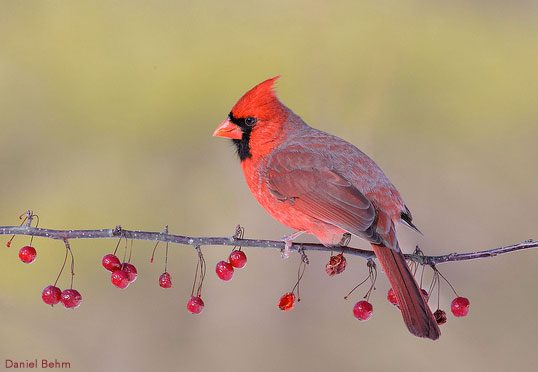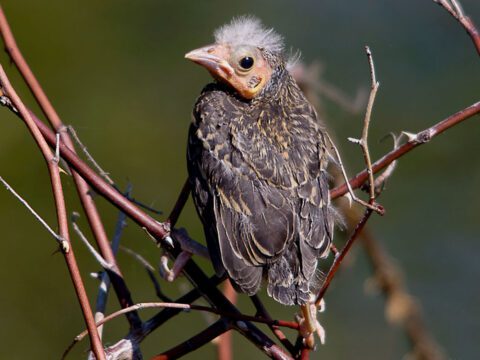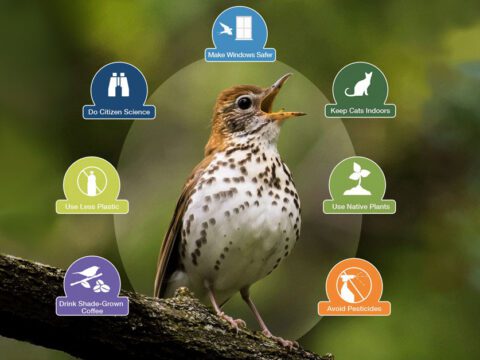Why So Red, Mr. Cardinal? NestWatch Explains
By Jason Martin and Robyn Bailey, leaders of our Nestwatch project March 5, 2013
In many parts of North America, handsome male Northern Cardinals are already singing to attract mates. A bird so visible in the winter landscape begs the question, “How does a flame-red bird that nests close to the ground manage to be so common?”
Many people puzzle over how this conspicuous species can be so successful, despite its low rate of nesting success. Typically, fewer than 40 percent of nests fledge at least one young. And if predation is a problem for cardinals, why don’t the males try to blend in a little more? Our NestWatch team has some answers, fed by details of cardinal nesting behavior gleaned from the 268 nesting attempts reported to the program so far.
The answer may lie in their long breeding season. Cardinals do not migrate and can begin building nests as early as late February. They can continue nesting into late August or September, giving them plenty of opportunity to raise one or two broods of young per year.
Another factor could be that cardinals are habitat generalists. They can nest in open woodlands, dry shrubby areas, disturbed tangles, suburbs, backyards, and even deserts. And they seem to put their nests pretty much anywhere: a recent study in Texas found that cardinal nest sites weren’t particularly different from sites the researchers chose at random. This suggests that cardinals may not be limited by suitable nesting locations.
Cardinals build their nests in live trees, shrubs, or vine tangles, anywhere up to about 15 feet high. Higher nests, and nests placed in denser tangles, seem to offer some relief from predators. The bright male carries nesting material to the female, who does most of the building. She uses her big beak to crush twigs until they’re pliable, then bends them around her body to make a nest cup that fits her, wedged into a small fork of branches for support. The nest is a sophisticated structure that takes 3–9 days to build. By the end, it’s about four inches across and three tall, lined with a snug layer of grapevine bark and fine grasses and pine needles.
But how does the male get away with being so colorful? The flamboyant males sing from high perches and do not trade their breeding plumes for a drab winter coat—they seem like obvious targets for hawks. It turns out that male cardinals are probably bright and loud for the same reason: to advertise what good mates they’d make.
According to the Birds of the World, brighter males have higher reproductive success, hold better territories, and offer more parental care. The intensity of a cardinal’s redness is related to what he’s been eating. So when females see a bright male, it’s a signal that he’s healthy and holds a good territory. (Interestingly, recent research by Amanda Rodewald, the Cornell Lab’s new director of Conservation Science, shows that this relationship may be getting less reliable for cardinals in urban areas, because of the novel food sources available in town.)
By responding to redness as a sign of a promising mate, females have encouraged the evolution of bright coloring in males. This process is called sexual selection, and it’s an everyday example of a process that can lead to extraordinary creatures like the birds-of-paradise. At the same time, the female’s muted colors provide her (and her nest) with a protective camouflage that the male lacks. Furthermore, cardinals tend to have high survival rates, possibly because they don’t endure the stress of migration. The oldest recorded cardinals lived to be at least 15 and a half years old (one recorded in Pennsylvania and another in Virginia).
If you are lucky enough to find a cardinal nest this year, won’t you help us learn more about this fascinating species? Last year, NestWatch participants monitored a record 81 Northern Cardinal nests. Can we get more in 2013? Head over to NestWatch for tips, stats, and focal species information, plus details about how to monitor nests safely as part of this great, free project.

All About Birds
is a free resource
Available for everyone,
funded by donors like you
American Kestrel by Blair Dudeck / Macaulay Library




